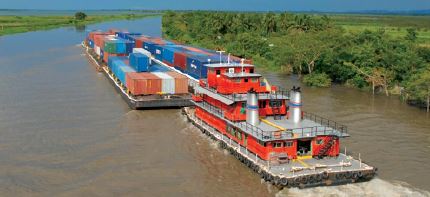Transport
[vc_row][vc_column width=”1/2″][vc_column_text]Transport is the lifeblood of international trade. More than 80 percent of world merchandise trade by volume is transported by sea. Over 793 million container TEUs (twenty-foot equivalent units) were handled in container ports in 2018. Asia has the largest share of container traffic (64 percent), followed by Europe (16 percent). The main trading route is the East-West main-lane (40 percent), which is the northern hemisphere seaborne trade between North America, Western Europe, and Asia. South-South trade is 12 percent and North-South trade is 8 percent. Going forward, new potential trade routes could be established in Arctic waters as the icecap melts. The proposed Kra canal across the Malay peninsula and a canal in Nicaragua would also have big impacts but may never eventuate. The widening and deepening of the canal locks in the Panama Canal in 2016, has enabled the New-Panamax class of container ships. Dry cargo was the largest cargo type by weight in 2018 (71 percent and 7.8bn metric tonnes loaded), followed by crude oil (17 percent), and other tanker cargo (12 percent). Dry bulk goods were the largest component of dry cargo trade (5.2bn tonnes) with iron ore the largest sub-type (28 percent of dry bulk) and coal (24 percent). The largest iron ore exporter is Australia (57 percent market share) with the largest importer China (71 percent share). The largest container ports by throughput were Shanghai (42m TEUs), Singapore (36.6m), Ningho-Zhousan (26.4m), Shenzhen (21.9m), Guangzhou (21.9m), and Busan (21.6m). The largest container operators in May 2017 were Maersk (16 percent market share), the Mediterranean Shipping Company (14.6 percent), and CMA-CGM (11.1 percent). Most container ships were registered in Panama (18.4 percent by dead-weight tonnage), followed by Liberia (11.8 percent), the Marshall Islands (11.6 percent), and Hong Kong (9.3 percent). But Greece leads in terms of beneficial ownership (16.7 percent), followed by Japan (12.1 percent). There continues to be an oversupply of vessels despite the global fleet continuing to decrease in recent years. In recent years international efforts have been made to reduce greenhouse gas emissions from international shipping. In 2012, international shipping accounted for 2.2 percent of human CO2 emissions.[/vc_column_text][/vc_column][vc_column width=”1/2″][vc_column_text]
Recovering the Magdalena River Waterway: Challenge Accepted
Loading, Please Wait!
This may take a second or two.















































































